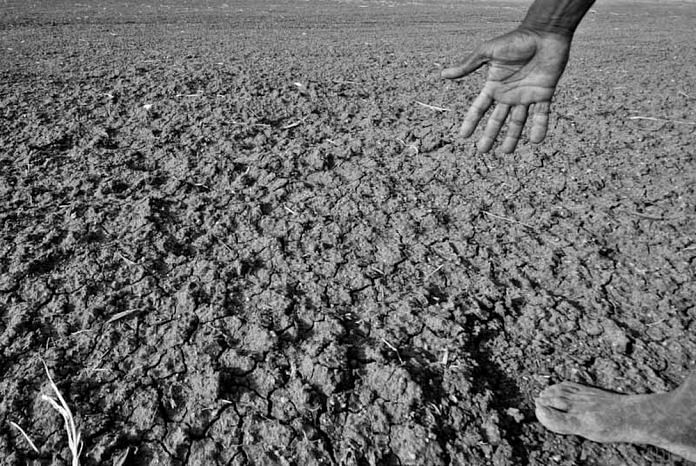Bengaluru: Elections in the southern states of India came and went with hardly a mention of the biggest challenge confronting them — drought and a growing water crisis.
India has faced nearly 20 per cent rainfall deficiency since the beginning of this year, and of the many states in the country reeling under an acute water shortage, Andhra Pradesh, Telangana, Karnataka and Tamil Nadu are some of the worst-affected. Most of the districts in these states have been marked as ‘red zones’, indicative of severe drought.
Drastic drop
Speaking to water experts, ThePrint has learnt that the drought situation this year could be worse than the one witnessed in 2016. The water levels have drastically reduced and borewells have to be dug up to 1,000 feet to get water, a Tamil Nadu irrigation official said on the condition of anonymity.
Groundwater levels in the districts of Tiruvallur, Kancheepuram, Dharmapuri, Tiruvannamalai and Vellore have dropped drastically. According to data available with the state Ground and Water Resources Data Centre, 19 out of the 32 districts in Tamil Nadu fall in the severe drought (red) category. Capital Chennai has also begun facing a severe water shortage.
“In Andhra Pradesh’s Chittoor, which is CM Chandrababu Naidu’s constituency, people have no water and are saving it for drinking and cooking purposes by taking bath just once a week,” said Telkapalli Ravi, a political analyst from Hyderabad.
Also read: These Maharashtra drought-hit farmers don’t need banks & loans. They’re funding each other
‘Politicians not interested in farmer woes’
In Cholenahalli village of Tumkur district, about 70 km from Bengaluru, Kempamma rushes through her daily chores to ensure she reaches the water tanker on time. She is one of the thousands of women who brave the sweltering heat to get a pot of drinking water.
Cholenahalli falls in one of the 165 talukas that have been declared severely drought-hit by the Karnataka government. And Kempamma says while politicians hovered all over the district during elections, seeking votes and promising borewells, water pumps and storage tanks, now they no longer seem interested in the farmers’ woes.
Kempamma’s neighbour Sharadamma, who’s facing the same problems, said: “We begged them to help us with our water problem. We hardly have water to drink, and they said they would do all that they can. Where are they now? Drought is an annual phenomenon and they should know by now that people are dying. Are we just a vote bank? Where is their responsibility towards us as representatives?”
Why didn’t it become a political issue?
Political analyst Harish Ramaswamy believes that the water crisis should have been an election issue, but neither the electorate nor the political parties took it up.
“As this was an election for Parliament, the electorate argued that it was a case for the state to deal with. The parties, being leader-centric, projected issues beyond the concerns of day-to-day life,” he said.
“The electorate seemed to realise that the parties’ projection of leaders was only in the interests of winning, and had nothing to do with solving local issues. Local problems should be solved by the local leadership.”
BJP’s Rajya Sabha MP V. Muraleedharan, who is the party’s Andhra Pradesh in-charge, agreed that in this election drought could have been the focal point of a vociferous campaign, but said it was a complex subject.
“I do agree that we should raise the tempo on such issues, because at the local level, in some areas, people are protesting against the lack of water and refusing to vote. But at the state level, it is not an issue, as drought is not uniform across regions,” Muraleedharan told ThePrint. “There are some places that are perpetually drought-prone. The basic technical problem is, whom do we blame? That is why political parties are not raising it.”
However, Brijesh Kalappa, Congress spokesperson and senior advocate who has been representing Karnataka in three water dispute cases, blamed the water scarcity on the lack of central leadership, while acknowledging the lack of clarity in taking up the issue of water scarcity. He put the blame squarely at the media’s door for not giving enough coverage to the drought.
“The media does not rake it up enough. If the PM makes a comment on Bofors during a speech, debates go on for hours on it. We too end up responding to these debates, but it is the responsibility of the media to also bring the drought to the fore,” Kalappa said.
Meanwhile, professor Narendra Pani of the National Institute for Advanced Studies, Bengaluru, said there is need to differentiate between macro and micro issues. Drought is largely seen as a state issue, one to be handled by local representatives. This, he said, is partly why it’s a difficult issue for political parties to tackle.
“This is why candidates become important during elections. People need to decide where the issue has been addressed or not. If not, then we see what we call ‘anti-incumbency’,” Pani said.
Also read: Climate change helped wipe out these four mighty ancient civilisations







Politics can’t bring rain